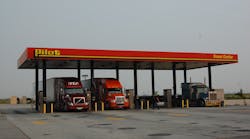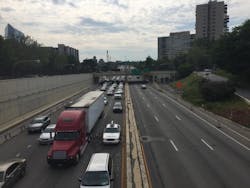ELDs remain a top fleet issue. But managing costs and traffic congestion are up there, too.
An annual survey compiled by global software provider Teletrac Navman finds (unsurprisingly) that compliance with the electronic logging device (ELD) mandate is one of the biggest concerns of U.S. fleets at this point in time – although most of the larger ones, operating over 100 pieces of equipment, expressed the “highest confidence” in meeting the mandate’s December 18 deadline.
That information is based on the responses of 118 U.S. transportation professionals polled as part of global survey Teletrac Navman conducted among 1,200 fleet operations and fleet management professionals.
The firm’s Telematics Benchmark Report: U.S. Transportation Edition focuses on just U.S. fleets, and though the sample size is on the small side, it’s still illustrative in terms of getting a bird’s eye view of what some of the major concerns in trucking – and no, it’s not all about ELDs, either.
For example, 47% of the U.S. transport professionals polled said managing costs is their biggest challenge, while dealing with “regulatory changes” is a distant second at 25%. Interestingly, “finding, retaining and developing talent” is tied with “minimizing vehicle and driver incidents” at 23%, according to Teletrac Navman’s findings.
In addition, the firm noted that 39% of respondents named reducing operational costs as their top business goal for 2017. “Margins are already thin across the industry due to expenses that companies cannot control, like fluctuating fuel costs,” Teletrac Navman said in its 16-page report.
Here’s another interesting finding: when it comes to identifying the biggest “infrastructure issues” faced by U.S. fleets, 47% of respondents made “traffic congestion” the top concern, followed quite distinctly by “aging roads and bridges” at 22%.
Thus it seems roadway throughput – or the lack of it – is something the much-ballyhooed (and so far largely non-existent) infrastructure funding plans of the Trump administration should make a top priority.Again, though, ELDs are the big worry – topping the list of “compliance concerns” for 73% of the fleets polled by Teletrac Navman. Here’s some more insight on that subject:
- On a scale of one to five, more than three quarters of organizations said they are confident that they will be ELD-ready by the December deadline, with large fleets (in the 101-500 and 500-plus ranges) reporting the highest confidence.
- Despite high driver concern about ELDs, 28% of organizations report doing nothing to address those concerns.
- For organizations already implementing ELDs, eliminating manual processes (30%), reducing risk of compliance violations (28%) and improving driver and public safety (16%) were rated as top benefits.
I’ve got to note that I find it perplexing – and concerning – that 28% of those polled in this survey blatantly said “they are doing nothing” to allay driver worries regarding ELDs.
Um, really? To put it bluntly, ELDs are loathed in many corners of the industry (a loathing that I think is misplaced) especially among older drivers. So one would think only a small number of fleet managers would disregard the negative emotions surrounding ELDs. Apparently that’s not so; at least as far as this survey is concerned.
Here are a few other interesting tidbits from Teletrac Navman’s poll:
- Some 61% of U.S. respondents plan to add vehicles and equipment during the next year to modernize their fleets, thereby reducing maintenance costs over time.
- To address the growing driver shortage, 58% said they reward drivers for good performance to improve retention, with 20% indicating they aim to hire more drivers within the next year.
- About 41% name implementing technology for regulatory compliance as their top planned investment during the next year.
- While nearly half of respondents report relying on paper records for hiring and business projections, 23% are now using big data tools.
A last note concerning the topic of theft: Interestingly and again noting these responses are drawn from a small sample size, theft of equipment and fuel seem to be of far greater concern to fleets than cargo theft.
According to Teletrac Navman, 34% of U.S. fleet professionals it polled are concerned about equipment theft and 29% about fuel theft, with theft of loads only the top concern among 18% of those surveyed – ranking it fifth on the list of theft types that fleets worry about.
That’s a lot of grist for trucking’s thought mill as we grind our way to the close of 2017.




